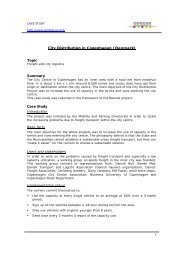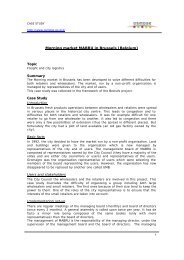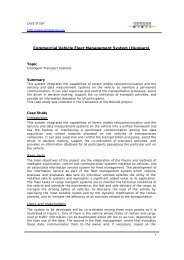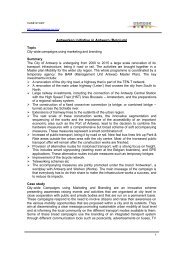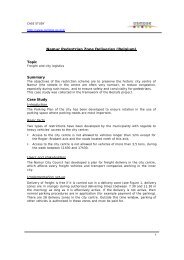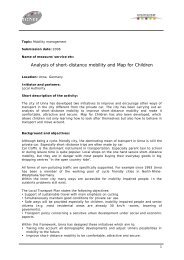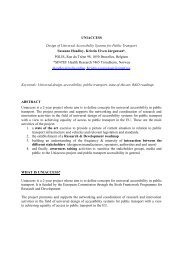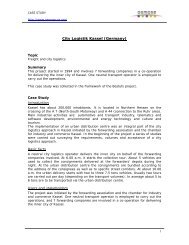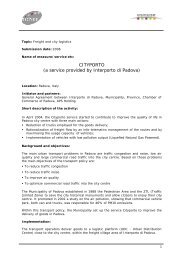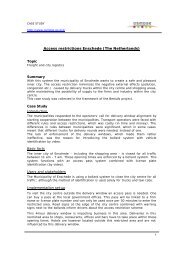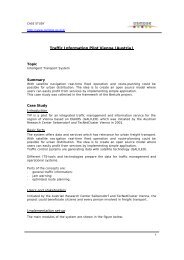Successful transport decision-making - Osmose
Successful transport decision-making - Osmose
Successful transport decision-making - Osmose
You also want an ePaper? Increase the reach of your titles
YUMPU automatically turns print PDFs into web optimized ePapers that Google loves.
FS 36: Measuring outcome indicators<br />
Vol 2 - Table of Contents <br />
Next<br />
<br />
T11<br />
What are outcome indicators?<br />
Outcome indicators measure the impacts, benefits and<br />
changes that are experienced by different stakeholder groups<br />
during or after implementation of the project.<br />
To determine what impact a project has had, it is necessary to<br />
compare conditions 'after' implementation with those that<br />
existed 'before' implementation, taking into account other<br />
external factors that may have had an influence on the<br />
observed outcome (e.g. changes in car ownership, or a<br />
national publicity campaign). Thus, monitoring outcome<br />
indicators needs to start before the project begins.<br />
Outcome indicators measure what impact the project has had,<br />
in terms of meeting underlying policy objectives. For example,<br />
are more people cycling now? Has car use decreased? Has air<br />
quality and traffic safety improved?<br />
The role of outcome indicators in<br />
evaluation<br />
Post-implementation evaluation examines the consequences of<br />
implementing a strategy or scheme, and how these relate to the<br />
intended consequences that provided the justification for going<br />
ahead with the project. Outcome indicators thus provide crucial<br />
information about the performance of the project and, in<br />
conjunction with data on resource consumption (i.e. input<br />
indicators), enable factors such as cost effectiveness to be<br />
assessed. Outcome indicators may need to be provided in the<br />
short, intermediate and long-term. The timing of a postimplementation<br />
evaluation (and the collection of the associated<br />
outcome indicators) is important, because if it is carried out too<br />
soon, the full impacts arising from the project may not be<br />
captured (e.g. build up of patronage on a new tram line).<br />
Conversely, if it is undertaken too late, resources will be wasted<br />
and similar projects will not benefit from the lessons learnt.<br />
Using outcome indicators<br />
Before selecting indicators, establish:<br />
Whether you need to compare your results with those from other<br />
projects, or to conform to certain reporting formats (e.g. national<br />
requirements for large infrastructure schemes);<br />
Over what time period the outcome indicators need to be<br />
measured;<br />
How the impacts of the project will be determined (e.g. by<br />
collecting 'before' and 'after' data; by collecting data in another<br />
area to control for the influence of external factors, by<br />
interviewing key stakeholders to assess their views on the<br />
projects impacts);<br />
What level of detail and accuracy is required (and your<br />
stakeholders expect) from the outcome indicators and<br />
evaluation; and<br />
What data already exists that might be used as part of the postimplementation<br />
evaluation.<br />
The focus of post-implementation evaluation: individuals or systems?<br />
Impacts and associated outcomes can be assessed at two main levels: the individual and the system levels. It is generally necessary<br />
to evaluate at both levels, but where the emphasis is placed will have a major impact on the types of outcome indicator selected, the<br />
data collection and analysis techniques, the time-frames, costs, etc.<br />
Individual level impacts measure the change of behaviour<br />
of individuals or similar groups of persons. At this level it might<br />
be necessary to have a 'target' group and a 'control' group, to<br />
establish whether the observed changes in behaviour are really<br />
due to implementing the project, or to some other external<br />
factors. This usually requires surveys and interviews. Members<br />
of the control group should have similar characteristics to the<br />
target group, and the data should be collected at the same time<br />
as for the target group.<br />
In order to identify what has changed and why, it is important to<br />
recognise that there are different stages in the behavioural<br />
change process, each of which may require monitoring, under<br />
certain circumstances. An example of such a behaviour change<br />
model from the European research project TAPESTRY is<br />
illustrated on the opposite page.<br />
At the system level, aggregate changes in the use of the<br />
<strong>transport</strong> system, or project impacts on, say, the environment<br />
are the centre of attention. At this level, some wider outcomes<br />
of a project can be evaluated, such as corridor accident<br />
reductions or increases in city centre economic activity. Much<br />
system level data is already collected by different agencies,<br />
though often large amounts of data have to be handled (e.g.<br />
continuous traffic counts), and judgements will need to be<br />
made about how to sample from or compress the data. Hence,<br />
data analysis and interpretation will be very different from that<br />
at the individual level, and requires different skills. Again, the<br />
question has to be addressed as to whether the observed<br />
changes or effects were caused by the project or other<br />
external factors or measures.<br />
PROJECT MONITORING<br />
Resources<br />
(Input Indicators)<br />
Activities / Actions taken<br />
(Process Indicators )<br />
Output<br />
(Output Indicators )<br />
Outcome Monitoring<br />
and Evaluation<br />
76



